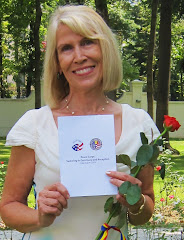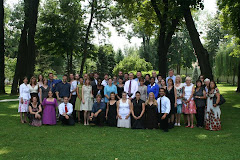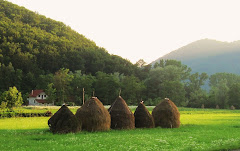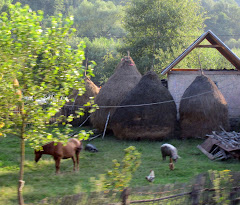
Returning to Romania after three months back home in the states reaffirms my affection for this land and gives me a whole different perspective as I learn about the Hungarian minority here, the history of Transylvania and of the origins of Unitarian beliefs. I’m writing from Okland, a beautiful little village in the Homerod valley in Transylvania. I and eight other members of my Unitarian Universalist congregation have come on a pilgrimage of sorts to our partner church. This is ancient territory, this particular village feeling obvious pride in being the burial place of Attila the Hun’s favorite wife, and the people of this area showing great satisfaction in being descendants of the famous warrior.**** We began in Budapest, seeing the sights there and enjoying a sweets festival and a wine tasting at a winery in Eger—seven large samplings that left us reeling and happy as we bought our bottles, convinced we had just had nectar of the gods. (Actually it IS very good wine and may someday soon be sold in Seattle).**** Upon entering Romania, we were immediately welcomed by my friends in Sintandrei with a small band of musicians, a cookout featuring traditional foods and drink and a lively performance of traditional dance by a troup of dancers who were friends of Mihai and Raluca. AND Mihai and Raluca even joined in on one number!

Ana, the matriarch, had prepared her best dishes of Romanian foods, and her husband Petre shared his home made palinka (plum brandy), afinata (blueberry liqueur) and cherry liqueur. We were given colorful woven bags filled with a small bottle of palinka and a jar of Ana’s special zacusca (pepper relish). Mihai had two video-tographers capture the evening and we’ve been promised the videos! We were only in “my city” of Oradea for a night and day, but I knew I would be returning on the 29th after the UU tour ends. I was glad that my American friends had this sampling of Romanian culture as the rest of the trip is almost exclusively Hungarian. Our tour guide, wife to the minister in our partner church, represents well the Hungarians in Transylvania who cling to their language, culture, and worship. Unitarianism is very popular with Hungarians, but some are also Lutheran, Calvinists, or Catholic. The Medieval Hungarian King Sigismund was Unitarian. We visited his tomb in the abbey of a medieval church (now Catholic) in Alba Julia. We also visited the medieval church in Turda where the Edict of (Religious)Toleration was signed in 1568, a direct result of Sigismund’s influence. Even though such progressive thinking had been present years before as the Reformation across Europe grew, for all practical purposes, it was the beginning of Unitarianism. **** This is a different Romania than I experienced as a Peace Corps volunteer. Here is a population who seems resentful of the oppression placed on them by the Romanians, themselves an oppressed people under many governments and rulers. It seems good King Sigismund’s ideal of toleration, religious and otherwise, is still an elusive state, difficult to reach and difficult to hold.**** Two more entries to come.

 Returning to Romania after three months back home in the states reaffirms my affection for this land and gives me a whole different perspective as I learn about the Hungarian minority here, the history of Transylvania and of the origins of Unitarian beliefs. I’m writing from Okland, a beautiful little village in the Homerod valley in Transylvania. I and eight other members of my Unitarian Universalist congregation have come on a pilgrimage of sorts to our partner church. This is ancient territory, this particular village feeling obvious pride in being the burial place of Attila the Hun’s favorite wife, and the people of this area showing great satisfaction in being descendants of the famous warrior.**** We began in Budapest, seeing the sights there and enjoying a sweets festival and a wine tasting at a winery in Eger—seven large samplings that left us reeling and happy as we bought our bottles, convinced we had just had nectar of the gods. (Actually it IS very good wine and may someday soon be sold in Seattle).**** Upon entering Romania, we were immediately welcomed by my friends in Sintandrei with a small band of musicians, a cookout featuring traditional foods and drink and a lively performance of traditional dance by a troup of dancers who were friends of Mihai and Raluca. AND Mihai and Raluca even joined in on one number!
Returning to Romania after three months back home in the states reaffirms my affection for this land and gives me a whole different perspective as I learn about the Hungarian minority here, the history of Transylvania and of the origins of Unitarian beliefs. I’m writing from Okland, a beautiful little village in the Homerod valley in Transylvania. I and eight other members of my Unitarian Universalist congregation have come on a pilgrimage of sorts to our partner church. This is ancient territory, this particular village feeling obvious pride in being the burial place of Attila the Hun’s favorite wife, and the people of this area showing great satisfaction in being descendants of the famous warrior.**** We began in Budapest, seeing the sights there and enjoying a sweets festival and a wine tasting at a winery in Eger—seven large samplings that left us reeling and happy as we bought our bottles, convinced we had just had nectar of the gods. (Actually it IS very good wine and may someday soon be sold in Seattle).**** Upon entering Romania, we were immediately welcomed by my friends in Sintandrei with a small band of musicians, a cookout featuring traditional foods and drink and a lively performance of traditional dance by a troup of dancers who were friends of Mihai and Raluca. AND Mihai and Raluca even joined in on one number! Ana, the matriarch, had prepared her best dishes of Romanian foods, and her husband Petre shared his home made palinka (plum brandy), afinata (blueberry liqueur) and cherry liqueur. We were given colorful woven bags filled with a small bottle of palinka and a jar of Ana’s special zacusca (pepper relish). Mihai had two video-tographers capture the evening and we’ve been promised the videos! We were only in “my city” of Oradea for a night and day, but I knew I would be returning on the 29th after the UU tour ends. I was glad that my American friends had this sampling of Romanian culture as the rest of the trip is almost exclusively Hungarian. Our tour guide, wife to the minister in our partner church, represents well the Hungarians in Transylvania who cling to their language, culture, and worship. Unitarianism is very popular with Hungarians, but some are also Lutheran, Calvinists, or Catholic. The Medieval Hungarian King Sigismund was Unitarian. We visited his tomb in the abbey of a medieval church (now Catholic) in Alba Julia. We also visited the medieval church in Turda where the Edict of (Religious)Toleration was signed in 1568, a direct result of Sigismund’s influence. Even though such progressive thinking had been present years before as the Reformation across Europe grew, for all practical purposes, it was the beginning of Unitarianism. **** This is a different Romania than I experienced as a Peace Corps volunteer. Here is a population who seems resentful of the oppression placed on them by the Romanians, themselves an oppressed people under many governments and rulers. It seems good King Sigismund’s ideal of toleration, religious and otherwise, is still an elusive state, difficult to reach and difficult to hold.**** Two more entries to come.
Ana, the matriarch, had prepared her best dishes of Romanian foods, and her husband Petre shared his home made palinka (plum brandy), afinata (blueberry liqueur) and cherry liqueur. We were given colorful woven bags filled with a small bottle of palinka and a jar of Ana’s special zacusca (pepper relish). Mihai had two video-tographers capture the evening and we’ve been promised the videos! We were only in “my city” of Oradea for a night and day, but I knew I would be returning on the 29th after the UU tour ends. I was glad that my American friends had this sampling of Romanian culture as the rest of the trip is almost exclusively Hungarian. Our tour guide, wife to the minister in our partner church, represents well the Hungarians in Transylvania who cling to their language, culture, and worship. Unitarianism is very popular with Hungarians, but some are also Lutheran, Calvinists, or Catholic. The Medieval Hungarian King Sigismund was Unitarian. We visited his tomb in the abbey of a medieval church (now Catholic) in Alba Julia. We also visited the medieval church in Turda where the Edict of (Religious)Toleration was signed in 1568, a direct result of Sigismund’s influence. Even though such progressive thinking had been present years before as the Reformation across Europe grew, for all practical purposes, it was the beginning of Unitarianism. **** This is a different Romania than I experienced as a Peace Corps volunteer. Here is a population who seems resentful of the oppression placed on them by the Romanians, themselves an oppressed people under many governments and rulers. It seems good King Sigismund’s ideal of toleration, religious and otherwise, is still an elusive state, difficult to reach and difficult to hold.**** Two more entries to come.







